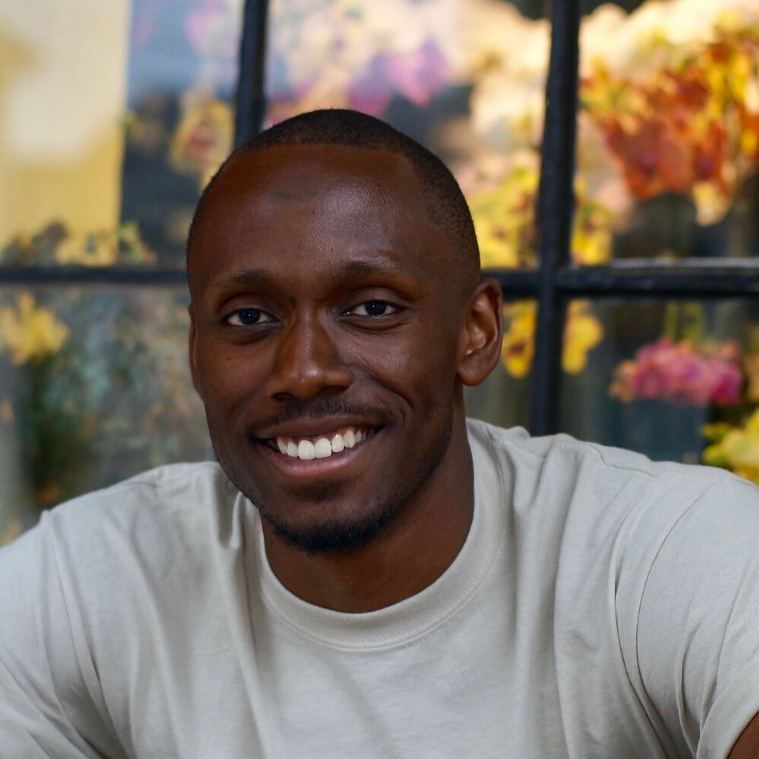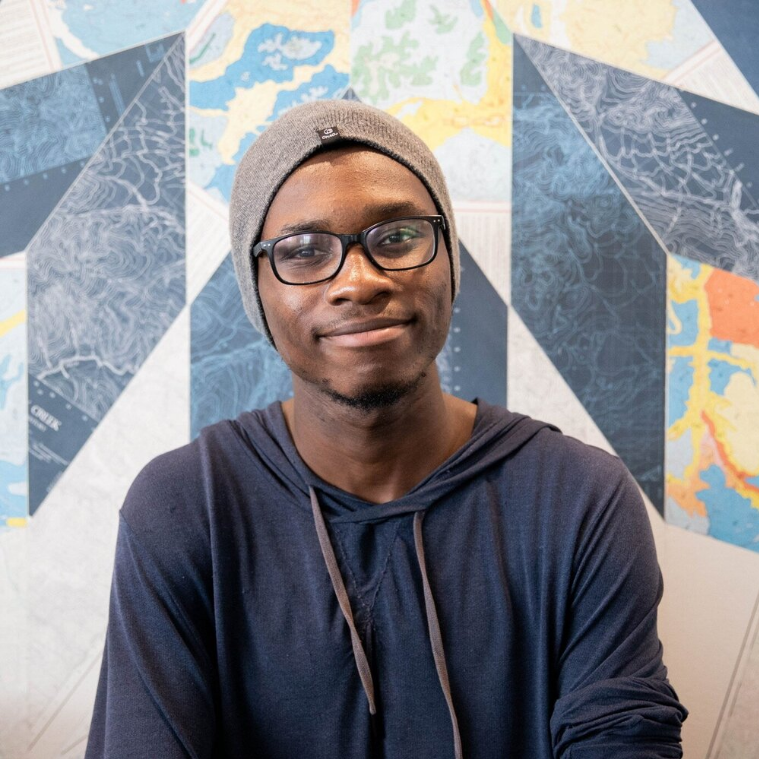It gives me tremendous pleasure to announce – Experimental Forest Films, with the generous support of their independent filmmaking peers, are pleased to announce the recipients of the inaugural New Works Grant. The first iteration of this initiative was announced in July as a peer adjudicated grant of $2000 which would be awarded to one Black filmmaker living on the unceded lands known as British Columbia. There was so much support and contributions from the film community that the grant was awarded to 4 lucky participants.
It was created by Kathleen Hepburn and Tyler Hagan (The Body Remembers When the World Broke Open)
After getting the introductions out of the way, it was time to hear more about this terrific grant and its beneficiaries.
My first question was for Tyler Hagan of Experimental Forest Films.
HNM “How did this grant come to fruition and how did you know it would be a success?”
Tyler “We weren’t sure if it would succeed but in June we felt, with everything going on between Covid-19 and how engaged we are in the Vancouver film community – especially with Indigenous cinema, that there were some large blind spots where people were not being supported in the community. We knew we could do something and we ought to do something… and we were inspired by Ava DuVernay’s company ARRAY. They’re a production and distribution company that picked up our previous film, The Body Remembers When the World Broke Open and we were able to go down to their facility/creative campus, where they do different facets of programming, they’ve got writers rooms, editors ‘rooms, a screening room and they create initiatives. The backbone/mandate of their company is uplifting women of all backgrounds by offering grants and initiatives. They back up everything they stand for and are the real deal – which inspired us to act and this is one of many initiatives that we’d decided to do.”
HNM “Do you foresee your company doing this again in the future?”
Tyler “Yes, it’s definitely been an amazing and positive experience – to see the sheer number of applications with quality projects submitted by talented people. It’s definitely going to be part of our new mandate as our company moves toward more community building and we’re looking at ways to make this an annual grant.”
This grant can be a game changer to an indie filmmaker trying to finance a project with a story that needs to be told. I had 4 other guests/recipients of the grant awaiting my questions, so I began with Edward Madojemu and his 3D animation project Lightcatchers. It’s about a young Nigerian student who is suddenly confronted by supernatural creatures that feed on electricity.
HNM “How long is your animation going to be?”
Edward “It’s expected to be between 3-4 mins… but sometimes things go very differently (laughing)”
HNM “How did you come up with the story?”
Edward “It’s actually a personal story – I’m an international student from Nigeria and I moved to Vancouver in 2017 to study at Emily Carr. One of the biggest differences I’d noticed upon moving here was how stable the electricity was in comparison to back home, where we always expect it to go out. I wanted to demonstrate to people that aren’t aware of the situation, what the day to day living would be like, but in a more palatable and playful way. These creatures represent the allegory for the entity of all the electricity we have that acts like an antagonist as it syphons power away from the homes. I wanted to show the day-to-day living but frame it in a more fantastical way.”
HNM “Is this the first time you’ve received a filmmaking grant?”
Edward “Yes, it is.”
HNM “What does this grant mean to you?”
Edward “It’s amazing! I was expecting to work on this project during class and on weekends. To have this support is incredible and I wasn’t expecting this at all… I’m over the moon.”
HNM “What stage are you at in the project?”
Edward “I’m in the final stages of preproduction – the characters are starting to be made and a couple are already finished, the sets are being developed and the animation acting is set to start in mid – October.”

Many of us don’t realize what we take for granted and that there are still many other under developed countries that treat our common amenities as luxuries and they cannot be forgotten. My next guest was Sideah Alladice and she is making an auto-documentary Hear Me to See Me. It is about her experience as a survivor of sexual assault.
HNM “This must be an incredibly hard story to tell. How difficult was it to put that experience out there?”
Sideah “I think that the process of filming and editing it was somewhat of an odd reaction… but I’d already spent so much time having my voice diminished as a woman of colour in a senior management position – in a male dominated society. I felt like I had to make this film… I didn’t know how to process what I was feeling and this is what came of it.”
HNM “Do you want to use this film to warn other women of the dangers of sexual assault or is the message, one of survival?”
Sideah “I want this story to be a platform for ‘champions for change’. There isn’t any protection for women working in the restaurant industry – and since the ‘Me Too’ movement, there hasn’t been a lot of change. There is an instructor that can prevent these assaults from happening but I’d like to shine a light on my own experience as a survivor but also be a champion for change. I also want this film to encourage other women to speak up and for employers to take note on the realities of the workplace and to take the necessary measures for change.”
HNM “Have you begun production on the project?
Sideah “Not yet, I wanted to leave a bit of a gap between this film and the next project in order to show the contrast of my personal experience and how it changed me as a person and what those results look like.”
HNM “When do you hope to begin production on the film?”
Sideah “I hope to begin in December or January.”
HNM “Will the grant go towards equipment rental?”
Sideah “Absolutely… it is a tremendously huge help.”
HNM “What types of films have you made in the past?”
Sideah “I haven’t made any films prior to this but I was very motivated to do something.”
HNM “Welcome to the filmmaking world and I hope to see your film next year.”

The stories coming out of these new but very talented filmmakers were beyond my expectations and they were all impactful topics. Nifemi Madarikan was my next guest and his narrative short film, Dogfall is about a young man, who after committing a heinous crime, is sentenced to a transformative justice program rather than jail-time.
HNM “Where did the idea for this film come from?”
Nifemi “I started working on Dogfall last year. At that time, a lot of social justice activists I’d been working with in Seattle started a conversation on how the working environmental justice system intersects with war ground healing, restorative justice and transformative. We began to acknowledge that there is an intersection of justice and alternative modes of healing and rehabilitating communities; there’s also an intersection between that and the environmental focus that we had at the time. I then read the book, ‘The Revolution Starts at Home’ which is a watershed collection of manifesto’s and essays centered on ‘transformative justice work’. I felt incredibly inspired by this alternative to engaging with crime and how we think about punishment. 2020 happened… and with everything that’s happened with Ahmaud Arbery to Breonna Taylor to George Floyd, there’s so much needed attention around justice and how we think about justice in the US and all over the world. Those events have inspired me to take the project more seriously than the previous year. I poured myself into it and trusted that it would take me where I needed to go.”
HNM “What would an alternative transformative justice program look like?”
Nifemi “This story takes us through a few stories happening simultaneously. One night a violent crime is committed and a few weeks later we see the community’s response to the sentencing given to the offender. Instead of facing prison, our protagonist is committed into a healing justice program, that sees them work through reconciliation with the survivor as well as group therapy, rehabilitative sessions and at the core of all the work is a practise centered on building accountability as well as cultivating a language around ‘what we do’ and what is ‘done to us’ and how we are impacted and how we impact others. That’s the idea that the transformative justice program is centred on. Some folks are not in favour of the criminal going through an alternative program like this versus the traditional incarcerated system. However, there are others that really do commend the progressiveness that programs like this hold.”
HNM “Do you believe this alternative justice program could be applied to multiple types of criminals and crimes?”
Nifemi “For this film, a big source of inspiration came from a Canadian documentary called Hollow Water, which can be found on the National Film Board website. That film follows an Indigenous community working through generational trauma and sexual assault within their community. In addition to incarcerable or punitive measures, a lot of the offenders are taken through a transformative justice process… that sees them unpack their trauma and also the trauma they inflict onto others. We as the audience, are able to follow these communities as they heal together – as difficult as that may be.”
HNM “What stage are you at in the project?”
Nifemi “We’re still in pre-production at the moment and we hope to go to camera in the summer of next year.”
The justice system does need a major overhaul starting with the police force and then the reform/punishment/incarceration institutions. Inmates keep re-offending once released and the victims are revictimized. Nifemi has the power to make society think about reform and the victims outside the pigeon-holed/cookie-cut system we currently have. One person can make change and all of these filmmakers are behind the wheel steering toward that.

My next and final guest is Omorose Osagie and she is creating a 2D animation, The Glass Doll. It’s a post-apocalyptic film in a world of toys, where a broken porcelain doll that repairs other broken toys, must decide between fixing herself and giving up her closest friend.
HNM “This sounds like a very sad dilemma – where did this idea for the story come from?”
Omorose “I’m still in film school and it was an idea for my project. I was thinking of an ironic situation when I came up with the idea of a broken doll that fixes other toys for a living… it was an interesting idea to explore. Usually I’ll make films in the speculative or fiction themed based, such as sci-fi or fantasy – but in a subtle way. I also want to focus on representation of diversity in the film.”
HNM “What is the biggest message in this film?”
Omorose “At the end of the story, she ends up trading her friend for a glass eye, which was broken on her… but when she goes home to try it on – the eye doesn’t fit. The bigger message is; explore imperfections and friendships… at the intersection of both of those, your friends don’t require you to be perfect, but people tend to focus on their own features too much, especially on social media and other places.”
HNM “It sounds like you’ve put an incredible amount of thought into the message in this film. Have you put other strong messages into previous films?”
Omorose “Yes I have – I’ve just completed my first short film, The Wolf that Chased the Sun in April. It was exploring whistleblowers, technology and stealing data from users and what-not. There was an over-arcing message in that film as well.”
HNM “When do you hope to get started on it?”
Omorose “We’re in pre-production right now, we have all the concept designs and we’re working on background concept storyboarding and hopefully we’ll move forward with production in January.”
HNM “Is there a deadline for completion of the films?”
Omorose “No, I don’t think so.”
Tyler “The idea behind the grant, is that it’s a project-based grant and its meant to be artistic development’ funding, and is designed to support these artists in relationship to these projects.
HNM “Where do you see Experimental Forest Films going in the next year?”
Tyler “Currently, we’re producing feature narrative films as well as executive producing a few narrative documentary films. We’re on hiatus with the rest of the industry but I hope to have a couple feature films in production next year. We also want to continue with the community initiative and to make this grant an annual one. We’re also hosting a free writing workshop for people to apply to. It will be taught by writer, Kathleen Hepburn and another colleague, Gorrman Lee – who is a television writer. There should be an announcement next week with a list of the first group attending the workshop.
All four of these talented Black filmmakers were thankful for the New Works Grant and I sense that their soon-to-be contributions will have a positive impact on their audiences long after the curtains close. Four different stories being told by 4 creative minds is a magical thing. Thanks to Experimental Forest Films, their films have the boost they need for that next level.
Thanks to the very generous Vancouver film community for contributing to this grant. They are as follows: Ceroma Films, Colin Browne, Common Knowledge Films, JBH Studios, Jean Parsons, Jeremy Cox, Josephine Anderson, Lewis Bennett, Liz Cairns, Matthew Hayashi, Rodeo Queen Pictures, Sara Blake, Savath Pictures, Time Lapse Pictures, Tony Massil, and Violator Films

